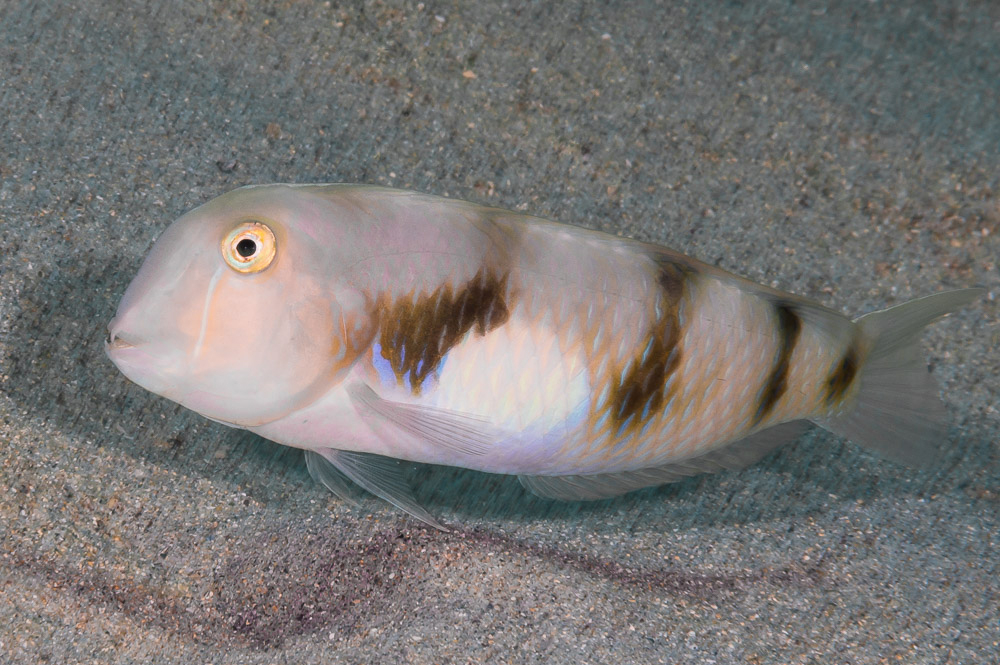- Classification
- ACTINOPTERYGII
- PERCIFORMES
- LABRIDAE
- Iniistius
- aneitensis
Whiteblotch Razorfish, Iniistius aneitensis (Günther 1862)
Other Names: Pale Razorfish, White Blotch Razorfish, White-blotch Razorfish, Whitepatch Razorfish, Yellowblotch Razorfish

A Whiteblotch Razorfish, Iniistius aneitensis, at North Rinca Island, Komodo National Park, Indonesia, April 2015. Source: zsispeo / Flickr. License: CC by Attribution-NonCommercial-ShareAlike
Summary:
A razor wrasse with a large white patch on the side. Males have a faint yellow patch in front of the white patch, and the patch is darker in females. Juveniles have three dark bands on the body that reduce in size with growth becoming one to three dark spots along the back.
Razorfish live in a harem defended by a single large male.
Species of the genus Iniistius have highly compressed bodies and a steep forehead with a firm knife-like anterior edge - enabling them to easily dive into the sand when threatened.
Razorfish live in a harem defended by a single large male.
Species of the genus Iniistius have highly compressed bodies and a steep forehead with a firm knife-like anterior edge - enabling them to easily dive into the sand when threatened.
Cite this page as:
Bray, D.J. 2019, Iniistius aneitensis in Fishes of Australia, accessed 02 Jul 2025, https://fishesofaustralia.net.au/Home/species/293
Whiteblotch Razorfish, Iniistius aneitensis (Günther 1862)
More Info
|
Distribution |
Great Barrier Reef and offshore reefs of the Coral Sea; also Christmas Island and Cocos (Keeling) Islands in the eastern Indian Ocean, and Lord Howe Island in the Tasman Sea. Elsewhere, the species is widespread in the Indo-west-central Pacific from Zanzibar to Hawaii. Inhabits open, clean, sandy areas of reef lagoons and seaward slopes at depths of 6-91 m. When threatened during the day, they dive into the sand, and also sleep there at night to avoid predators. |
|
Biology |
Razorfish are protogynous sequential hermaphrodites (sex-change from female to male) and live in a harem defended by a single large male. |
|
Species Citation |
Novacula aneitensis Günther, 1862, Cat. Fish. Brit. Mus. 4: 176. Type locality: Aneiteum, Vanuatu. |
|
Author |
Bray, D.J. 2019 |
|
Resources |
Whiteblotch Razorfish, Iniistius aneitensis (Günther 1862)
References
Allen, G.R. 1997. Marine Fishes of Tropical Australia and South-east Asia. Perth : Western Australian Museum 292 pp. 106 pls. (as Xyrichtys aneitensis)
Allen, G.R. & Erdmann, M.V. 2012. Reef fishes of the East Indies. Perth : Tropical Reef Research 3 vols, 1260 pp.
Allen, G.R. & Smith-Vaniz, W.F. 1994. Fishes of Cocos (Keeling) Islands. Atoll Research Bulletin 412: 1-21. (as Xyrichtys aneitensis)
Allen, G.R. & Steene, R.C. 1979. The Fishes of Christmas Island, Indian Ocean. Aust. Natl. Parks Wldlf. Ser. Spec. Publ. 2. Canberra : Australian Government Publishing Service 81 pp. 15 pls. (as Xyrichtys aneitensis)
Allen, G.R. & Steene, R.C. 1988. Fishes of Christmas Island Indian Ocean. Christmas Island : Christmas Island Natural History Association 197 pp. (as Xyrichtys aneitensis)
Francis, M. 1993. Checklist of the coastal fishes of Lord Howe, Norfolk, and Kermadec Islands, southwest Pacific Ocean. Pacific Science 47(2): 136-170 figs 1-2 (as Xyrichtys aneitensis)
Francis, M.P. & Randall, J.E. 1993. Further additions to the fish faunas of Lord Howe and Norfolk Islands, southwest Pacific Ocean. Pacific Science 47(2): 118-135 figs 1-22 pls 1-4 (as Xyrichtys aneitensis)
Günther, A. 1862. Catalogue of the Fishes in the British Museum. Catalogue of the Acanthopterygii Pharyngognathi and Anacanthini in the collection of the British Museum. London : British Museum Vol. 4 534 pp.
Hobbs, J-P.A., Newman, S.J., Mitsopoulos, G.E.A., Travers, M.J., Skepper, C.L., Gilligan, J.J., Allen, G.R., Choat, H.J. & Ayling, A.M. 2014. Checklist and new records of Christmas Island fishes: the influence of isolation, biogeography and habitat availability on species abundance and community composition. Raffles Bulletin of Zoology Supplement 30: 184–202
Hobbs, J-P.A., Newman, S .J., Mitsopoulos, G.E.A., Travers, M.J., Skepper, C.L., Gilligan, J.J., Allen, G.R., Choat, H.J. & Ayling, A.M. 2014. Fishes of the Cocos (Keeling) Islands: new records, community composition and biogeographic significance. Raffles Bulletin of Zoology Supplement 30: 203–219
Kuiter, R.H. 1992. Tropical Reef-Fishes of the Western Pacific, Indonesia and Adjacent Waters. Jakarta : PT Gramedia Pustaka Utama 314 pp. pls.
Kuiter, R.H. 1996. Guide to Sea Fishes of Australia. A comprehensive reference for divers and fishermen. Sydney, NSW, Australia : New Holland Publishers xvii, 434 pp. (as Xyrichtys aneitensis)
Kuiter, R.H. 2010. Labridae fishes: wrasses. Seaford, Victoria, Australia : Aquatic Photographics pp. 398. (as Xyrichtys aneitensis)
Kuiter, R.H. & Tonozuka, T. 2001. Pictorial guide to Indonesian reef fishes. Part 2. Fusiliers - Dragonets, Caesionidae - Callionymidae. Australia : Zoonetics pp. 304-622. (as Xyrichtys aneitensis)
Lieske, E. & Myers, R.F. 1994. Collins Pocket Guide. Coral reef fishes. Indo-Pacific and Caribbean including the Red Sea. Harper Collins Publishers, New York, USA. (as Xyrichtys aneitensis)
Oxley, W.G., Ayling, A.M., Cheal, A.J. & Thompson, A.A. 2003. Marine surveys undertaken in the Coringa-Herald National Nature Reserve, March-April 2003. Townsville : Australian Institute of Marine Science 59 pp. (as Xyrichtys aneitensis)
Randall, J.E. 2005. Reef and shore fishes of the South Pacific. New Caledonia to Tahiti and the Pitcairn Islands. Honolulu : University of Hawaii Press 707 pp.
Randall, J.E., Allen, G.R. & Steene, R. 1990. Fishes of the Great Barrier Reef and Coral Sea. Bathurst : Crawford House Press 507 pp. figs. (as Xyrichtys aneitensis)
Randall, J.E. & Earle, J.L. 2002. Review of the Hawaiian razorfishes of the genus Iniistius (Perciformes: Labridae). Pacific Science 56(4): 389-402.
Russell, B. 2010. Iniistius aneitensis. The IUCN Red List of Threatened Species 2010: e.T187395A8523363. http://dx.doi.org/10.2305/IUCN.UK.2010-4.RLTS.T187395A8523363.en. Downloaded on 09 January 2019.












